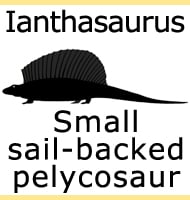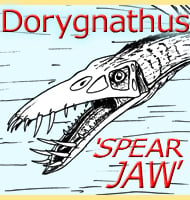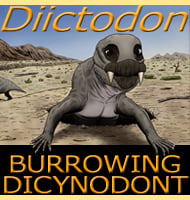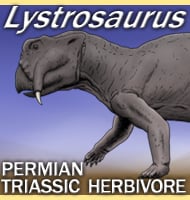In Depth
The one thing about Basilosaurus that instantly causes confusion is its name. When first studied and named by Richard Harlan, he came to the conclusion that it was most likely a marine reptile, and so named it Basilosaurus, or ‘King lizard’. It was not until the remains were studied by Richard Owen that they were confirmed as mammalian. Owen then proposed that Basilosaurus should be renamed Zeuglodon (Yoke teeth), but because Basilosaurus was the officially registered name, it could not be changed, so Zeuglodon became a synonym instead of a replacement.
Basilosaurus represents one of the earliest whales although its actually descended from terrestrial mammals like Ambulocetus. Evidence for this can be seen in the flippers. The front flippers still have an elbow joint, something that today is only seen in seals. The back flippers where the hind legs would have been in its ancestor are greatly reduced and although they may have been used to get extra grip on a mate, they would eventually disappear in later whales. The size of its flippers in comparison with the massive bulk of its body means that it was almost certainly an entirely pelagic animal.
The large jaws of Basilosaurus housed teeth suitable for catching prey that would not have been especially small, perhaps smaller whales or large fish that while smaller than Basilosaurus, but were still too large for most other predators to tackle. Superficially the fossils of Basilosaurus skulls resemble the skulls of mosasaurs that swam the oceans tens of millions of years earlier, disappearing from the fossil record at the time of the KT extinction 65 million years ago. It is partly for this reason that Basilosaurus was misidentified as a reptile because mosasaur remains were known, yet no one was aware that the early whales looked so similar. The skull also has a reduced area for the brain when compared to modern whales. Going on the basis that larger brained cetaceans are typically more social, Basilosaurus itself may have been a solitary predator. Although not preserved, the structure of the tail vertebrae suggests support for a tail fluke as seen in modern cetaceans. The reduced limbs would probably have been of little use in actual locomotion leading to the suggestion that Basilosaurus used an undulating motion to propel itself in the water. This up and down motion may have also provided quick bursts of speed at prey items.
Study of the Basilosaurus skeleton has revealed that it was quite restricted in terms of movement. Muscle attachments along the spine imply that Basilosaurus had relatively weak muscles and could neither dive deep nor swim for extended periods, at least at what may have been pursuit speed for prey. The vertebrae, unlike modern whales which are solid, were hollow and likely filled with fluid. This is not an adaptation for a deep sea creature, as pressure imbalance between the fluid in the hollow vertebrae and stronger pressure of deep water outside could in theory cause spinal injury with the vertebrae being crushed if the pressure became too much. Together, these all point to an animal that only swam and hunted in waters near the surface.
In 1845, Dr Albert Koch constructed a composite animal from numerous specimens of Basilosaurus remains. This composite was named Hydrarchos and went on a touring display around the world until its destruction in the Great Chicago fire in 1871. Aside from never existing, the material was presented as a sea serpent, not a whale. Also not only was their more than one Basilosaurus individual used in the construction, fossils from other animals were also included. Despite the fact that other scientists of the time were quick to point out that it did not represent a real creature, references to it as a real animal are still sometimes made by those who are not knowledgeable about this history, although thankfully this is getting rarer.
Further Reading
– Hind limbs of eocene Basilosaurus: evidence of feet in whales”. Science. 249 (4965): 154–157. – Philip D. Gingerich, B. Holly Smith & Elwyn L. Simons – 1990. – Basilosaurus drazindai and Basiloterus hussaini, New Archaeoceti (Mammalia, Cetacea) from the Middle Eocene Drazinda Formation, with a Revised Interpretation of Ages of Whale-Bearing Strata in the Kirthar Group of the Sulaiman Range, Punjab (Pakistan). – Contributions from the Museum of Paleontology, University of Michigan. 30 (2): 55–81. – P. D. Gingerich, M. Arif, M. Akram Bhatti, M. Anwar & William J. Sanders – 1997. – Priabonian Basilosaurus isis (Cetacea) from the Wadi Esh-Shallala Formation: first marine mammal from the Eocene of Jordan. – Journal of Vertebrate Paleontology. 20 (1): 201–204. I. S. Zalmout, H. A. Mustafa & P. D. Gingerich – 2000. – Cranial asymmetry in Eocene archaeocete whales and the evolution of directional hearing in water. – PNAS. 108 (35): 14545–14548. – Julia M. Fahlke, Philip D. Gingerich, Roert C. Welsh & Aaron R. Wood – 2011. – Bite marks revisited – evidence for middle-to-late Eocene Basilosaurus isis predation on Dorudon atrox (both Cetacea, Basilosauridae). – Palaeontologia Electronica. 15 (3). – Julia M. Fahlke – 2012. – Basilotritus uheni, a New Cetacean (Cetacea, Basilosauridae) from the Late Middle Eocene of Eastern Europe. – Journal of Paleontology. 87 (2): 254–268. – Pavel Gol’din & Evgenij Zvonok – 2013. – Bone-Breaking Bite Force of Basilosaurus isis (Mammalia, Cetacea) from the Late Eocene of Egypt Estimated by Finite Element Analysis. – PLOS ONE. 10 (2): e0118380. – E. Snively, J. M. Fahlke & R. C. Welsh – 2015. – Stomach contents of the archaeocete Basilosaurus isis: Apex predator in oceans of the late Eocene. – PLOS ONE. 14 (1). e0209021. – Manja Voss, Mohammed Sameh M. Antar, Iyad S. Zalmout & Philip D. Gingerich – 2019.










